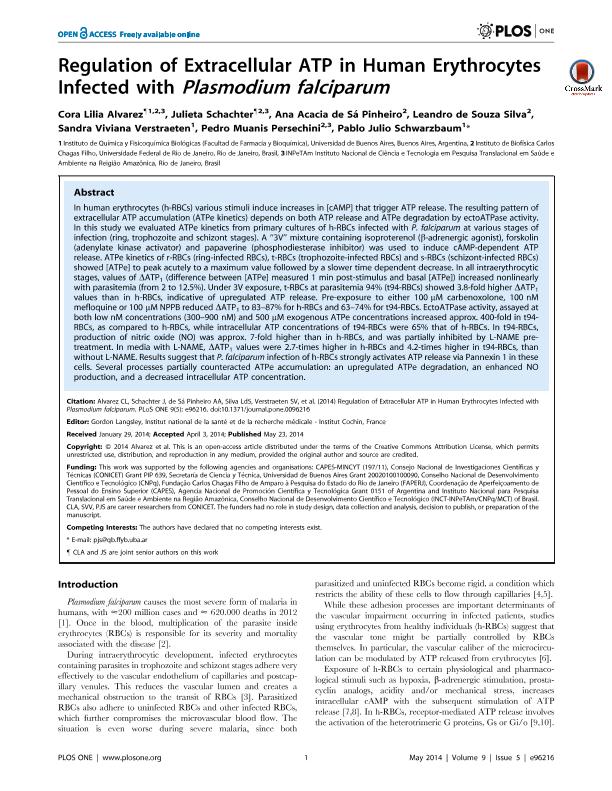Artículo
Regulation of extracellular ATP in human erythrocytes infected with Plasmodium falciparum
Alvarez, Cora Lilia ; Schachter, Julieta; Sá Pinheiro, Ana Acacia de
; Schachter, Julieta; Sá Pinheiro, Ana Acacia de ; Verstraeten, Sandra Viviana
; Verstraeten, Sandra Viviana ; Silva, Leandro de Souza; Muanis Persechini, Pedro; Schwarzbaum, Pablo Julio
; Silva, Leandro de Souza; Muanis Persechini, Pedro; Schwarzbaum, Pablo Julio
 ; Schachter, Julieta; Sá Pinheiro, Ana Acacia de
; Schachter, Julieta; Sá Pinheiro, Ana Acacia de ; Verstraeten, Sandra Viviana
; Verstraeten, Sandra Viviana ; Silva, Leandro de Souza; Muanis Persechini, Pedro; Schwarzbaum, Pablo Julio
; Silva, Leandro de Souza; Muanis Persechini, Pedro; Schwarzbaum, Pablo Julio
Fecha de publicación:
05/2014
Editorial:
Public Library Of Science
Revista:
Plos One
ISSN:
1932-6203
Idioma:
Inglés
Tipo de recurso:
Artículo publicado
Clasificación temática:
Resumen
In human erythrocytes (h-RBCs) various stimuli induce increases in [cAMP] that trigger ATP release. The resulting pattern of extracellular ATP accumulation (ATPe kinetics) depends on both ATP release and ATPe degradation by ectoATPase activity. In this study we evaluated ATPe kinetics from primary cultures of h-RBCs infected with P. falciparum at various stages of infection (ring, trophozoite and schizont stages). A “3V” mixture containing isoproterenol (β-adrenergic agonist), forskolin (adenylate kinase activator) and papaverine (phosphodiesterase inhibitor) was used to induce cAMP-dependent ATP release. ATPe kinetics of r-RBCs (ring-infected RBCs), t-RBCs (trophozoite-infected RBCs) and s-RBCs (schizont-infected RBCs) showed [ATPe] to peak acutely to a maximum value followed by a slower time dependent decrease. In all intraerythrocytic stages, values of ΔATP1 (difference between [ATPe] measured 1 min post-stimulus and basal [ATPe]) increased nonlinearly with parasitemia (from 2 to 12.5%). Under 3V exposure, t-RBCs at parasitemia 94% (t94-RBCs) showed 3.8-fold higher ΔATP1 values than in h-RBCs, indicative of upregulated ATP release. Pre-exposure to either 100 µM carbenoxolone, 100 nM mefloquine or 100 µM NPPB reduced ΔATP1 to 83–87% for h-RBCs and 63–74% for t94-RBCs. EctoATPase activity, assayed at both low nM concentrations (300–900 nM) and 500 µM exogenous ATPe concentrations increased approx. 400-fold in t94-RBCs, as compared to h-RBCs, while intracellular ATP concentrations of t94-RBCs were 65% that of h-RBCs. In t94-RBCs, production of nitric oxide (NO) was approx. 7-fold higher than in h-RBCs, and was partially inhibited by L-NAME pre-treatment. In media with L-NAME, ΔATP1 values were 2.7-times higher in h-RBCs and 4.2-times higher in t94-RBCs, than without L-NAME. Results suggest that P. falciparum infection of h-RBCs strongly activates ATP release via Pannexin 1 in these cells. Several processes partially counteracted ATPe accumulation: an upregulated ATPe degradation, an enhanced NO production, and a decreased intracellular ATP concentration.
Archivos asociados
Licencia
Identificadores
Colecciones
Articulos(IQUIFIB)
Articulos de INST.DE QUIMICA Y FISICO-QUIMICA BIOLOGICAS "PROF. ALEJANDRO C. PALADINI"
Articulos de INST.DE QUIMICA Y FISICO-QUIMICA BIOLOGICAS "PROF. ALEJANDRO C. PALADINI"
Citación
Alvarez, Cora Lilia; Schachter, Julieta; Sá Pinheiro, Ana Acacia de; Verstraeten, Sandra Viviana; Silva, Leandro de Souza; et al.; Regulation of extracellular ATP in human erythrocytes infected with Plasmodium falciparum; Public Library Of Science; Plos One; 9; 5; 5-2014; 1-14; e96216
Compartir
Altmétricas



